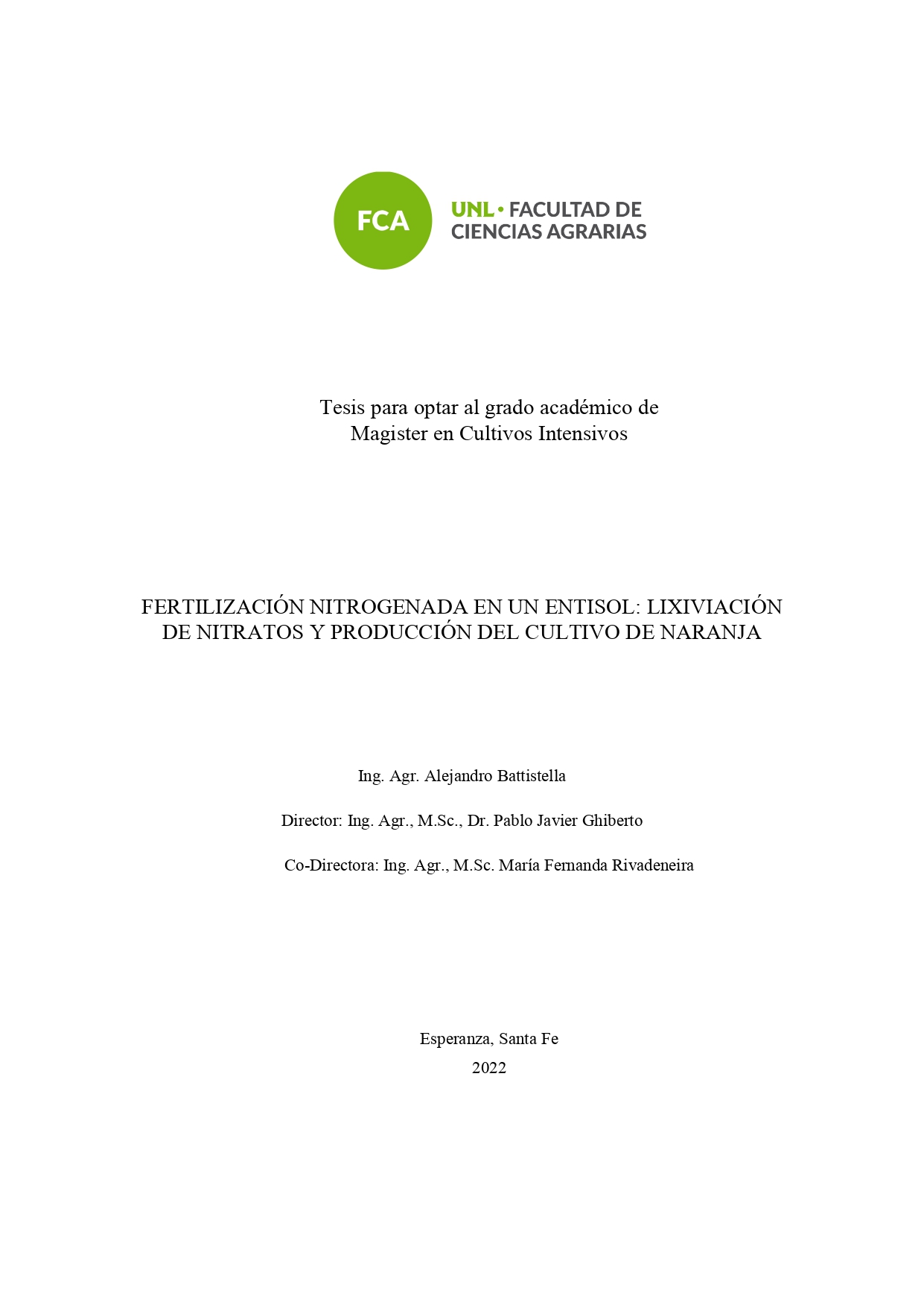View Item
- xmlui.general.dspace_homeCentros Regionales y EEAsCentro Regional Entre RíosEEA ConcordiaTesisxmlui.ArtifactBrowser.ItemViewer.trail
Fertilización nitrogenada en un entisol: lixiviación de nitratos y producción del cultivo de naranja
Abstract
En Entre Ríos, en la franja costera al Río Uruguay se encuentra aproximadamente un 26 % del total de la superficie plantada con cítricos en Argentina, principalmente sobre suelos arenosos de alta permeabilidad propensos a la lixiviación de nutrientes. El objetivo de este trabajo fue cuantificar la perdida de nitrógeno en forma de NO3- que lixivia con la solución del suelo bajo diferentes métodos de fertilización. A su vez medir la respuesta del
[ver mas...]
En Entre Ríos, en la franja costera al Río Uruguay se encuentra aproximadamente un 26 % del total de la superficie plantada con cítricos en Argentina, principalmente sobre suelos arenosos de alta permeabilidad propensos a la lixiviación de nutrientes. El objetivo de este trabajo fue cuantificar la perdida de nitrógeno en forma de NO3- que lixivia con la solución del suelo bajo diferentes métodos de fertilización. A su vez medir la respuesta del rendimiento, el contenido de nitrógeno en hojas, calidad interna de fruta y evaluar el comportamiento fenológico del cultivo ante dichos métodos. Para ello se realizó un ensayo durante 2 años en un lote de naranja Salustiana (Citrus sinensis Osbeck) donde se realizaron 3 tratamientos con 3 repeticiones, testigo (TG): testigo sólo con riego; fertirriego (FG): fertirrigación; voleo (VL): fertilización en superficie. FG y VL recibieron la misma dosis de N y todos los tratamientos la misma lámina de agua. En los años 1 y año 2 se evaluaron, la cantidad de N-NO3- lixiviado utilizando extractores de solución; el rendimiento, el contenido de nitrógeno en hojas, calidad interna de fruta y comportamiento fenológico del cultivo. En Año 1, fue mayor la cantidad de N lixiviado en todos los tratamientos comparado con Año 2. En Año 1 se obtuvieron en el tratamiento VL: 27,9 kg ha-1 de N, en comparación con los tratamientos FG: 11,8 kg ha-1 de N y TG: 2,4 kg ha-1 de N. En Año 2 se repite el comportamiento en los tratamientos, donde VL registró 11,3 kg ha-1 de N, seguido por los tratamientos FG 3,2 kg ha-1 de N y TG 1,2 kg ha-1 de N. Los rendimientos obtenidos en Año 1 fueron aproximadamente un 65% mayores que en Año 2. Se registraron en los tratamientos FG: 67,6 Mg ha-1, VL: 48,1 Mg ha-1 y TG: 56,9 Mg ha-1. En Año 2 se registraron rendimientos de FG: 44,3 Mg ha-1, VL: 29,2 Mg ha-1 y TG: 26,4 Mg ha-1. En el contenido de N en hojas se obtuvieron diferencias significativas a favor del tratamiento FG en comparación con VL y TG. La calidad de fruta y fechas de inicio de brotación / floración y plena floración no se vieron afectados significativamente en los diferentes tratamientos.
[Cerrar]
In Entre Ríos, approximately 26% of the total area planted with citrus in Argentina is located on the coastal strip of the Uruguay River, mainly on highly permeable sandy soils prone to nutrient leaching. The objective of this work was to quantify the loss of nitrogen in the form of NO3- that leaches with the soil solution under different fertilization methods. At the same time, measure the yield response, the nitrogen content in leaves, internal fruit
[ver mas...]
In Entre Ríos, approximately 26% of the total area planted with citrus in Argentina is located on the coastal strip of the Uruguay River, mainly on highly permeable sandy soils prone to nutrient leaching. The objective of this work was to quantify the loss of nitrogen in the form of NO3- that leaches with the soil solution under different fertilization methods. At the same time, measure the yield response, the nitrogen content in leaves, internal fruit quality and evaluate the phenological behavior of the crop before said methods. For this, a trial was carried out for 2 years in a lot of Salustiana orange (Citrus sinensis Osbeck) where 3 treatments with 3 repetitions were carried out, control (TG): control only with irrigation; fertigation (FG): fertigation; broadcast (VL): surface fertilization. FG and VL received the same dose of N and all the treatments the same layer of water. In years 1 and 2, the amount of NO3--N leached was evaluated using solution extractors; yield, nitrogen content in leaves, internal fruit quality and phenological behavior of the crop. In Year 1, the amount of leached N was greater in all treatments compared to Year 2. In Year 1, the VL treatment obtained: 27.9 kg ha-1 of N, compared to the FG treatments: 11.8 kg ha-1 of N and TG: 2.4 kg ha-1 of N. In Year 2 the behavior in the treatments is repeated, where VL registered 11.3 kg ha-1 of N, followed by treatments FG 3, 2 kg ha-1 of N and TG 1.2 kg ha-1 of N. The yields obtained in Year 1 were approximately 65% higher than in Year 2. They were recorded in the FG treatments: 67.6 Mg ha-1 , VL: 48.1 Mg ha-1 and TG: 56.9 Mg ha-1. In Year 2, FG yields were recorded: 44.3 Mg ha-1 VL: 29.2 Mg ha-1 and TG: 26.4 Mg ha-1. In the N content in leaves, significant differences were obtained in favor of the FG treatment compared to VL and TG. Fruit quality and start dates of budding/flowering and full bloom were not significantly affected in the different treatments.
[Cerrar]

Author
Director de Tesis
Ghiberto, Pablo Javier (director);
Descripción
Tesis para obtener el grado de Magister Scientiae en Cultivos Intensivos, de la Universidad Nacional del Litoral, en 2022
Date
2022
Editorial
Facultad de Ciencias Agrarias, Universidad Nacional del Litoral
Formato
pdf
Tipo de documento
tesis de maestría
Palabras Claves
Derechos de acceso
Abierto
 Excepto donde se diga explicitamente, este item se publica bajo la siguiente descripción: Creative Commons Attribution-NonCommercial-ShareAlike 2.5 Unported (CC BY-NC-SA 2.5)
Excepto donde se diga explicitamente, este item se publica bajo la siguiente descripción: Creative Commons Attribution-NonCommercial-ShareAlike 2.5 Unported (CC BY-NC-SA 2.5)


